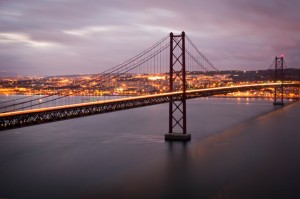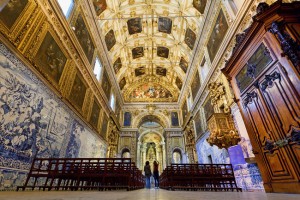My recommendations of places to visit in Lisbon..
Castelo de São Jorge
 The castle of Saint Joris rises high above Lisbon. This building was also damaged by the earthquake of 1755, but parts of it were beautifully restored. The view from the castle walls are breathtaking. The castle of Saint Joris is located high above Lisbon. It was built by the Moors on the remains of a fortress from the 5th century when Portugal was inhabited by the Visigoths. The Moors were during the Reconquista (Christian Reconquest) driven out by King Afonso Henriques in 1147.
The castle of Saint Joris rises high above Lisbon. This building was also damaged by the earthquake of 1755, but parts of it were beautifully restored. The view from the castle walls are breathtaking. The castle of Saint Joris is located high above Lisbon. It was built by the Moors on the remains of a fortress from the 5th century when Portugal was inhabited by the Visigoths. The Moors were during the Reconquista (Christian Reconquest) driven out by King Afonso Henriques in 1147.
There are two entrances, at the Largo do Chão da Feira to the Largo do Menino de Deus
Alfama
 The oldest district of Lisbon which was spared during the earthquake of 1755. It is a picturesque neighbourhood with narrow, winding streets and stairs. You will also find small bars where the traditional fado music performes every night. The name is derived from the Arabic Al-hamma (bath). Formerly stood at the foot of the Hill hot springs. Miraculously, this area was spared by the great earthquake of 1755.
The oldest district of Lisbon which was spared during the earthquake of 1755. It is a picturesque neighbourhood with narrow, winding streets and stairs. You will also find small bars where the traditional fado music performes every night. The name is derived from the Arabic Al-hamma (bath). Formerly stood at the foot of the Hill hot springs. Miraculously, this area was spared by the great earthquake of 1755.
Alfama, Lisbon
Mosteiro dos Jerónimos
 The best example of the ornate style. This construction style was widely used in Portugal and is named after King Manuel I. This monastery was in command of this King built as thanks for the successful voyage of Vasco da Gama to India. The Jeronimos Monastery (Jerome) is – even more so than the Torre de Belém – a symbol of the Portuguese power and wealth in the 15th and 16th centuries. Construction began in 1502 under architect Diogo de Boitaca. The base of the buildings is the Gothic, but that would change under fifteen years later building master João de Castilho. Who made the monastery into what it is today: a beautiful example of the so-called Manueline style.
The best example of the ornate style. This construction style was widely used in Portugal and is named after King Manuel I. This monastery was in command of this King built as thanks for the successful voyage of Vasco da Gama to India. The Jeronimos Monastery (Jerome) is – even more so than the Torre de Belém – a symbol of the Portuguese power and wealth in the 15th and 16th centuries. Construction began in 1502 under architect Diogo de Boitaca. The base of the buildings is the Gothic, but that would change under fifteen years later building master João de Castilho. Who made the monastery into what it is today: a beautiful example of the so-called Manueline style.
Praça do Império, Lisbon
Parque das Naçoes
 This park is a remnant of the world exhibition that was held in 1998 in Lisbon. Attractions include the Oceanarium, the largest aquarium in Europe and the knowledge Pavilion, where children playfully scientific experiments can do. In 1998 Lisbon organized the Expo. Some attractions of the exhibition are still to visit in the Parque des Naçoes. In addition, it is an entertainment centre with bars, restaurants, cinemas and the great Vasco da Gama shopping centre.
This park is a remnant of the world exhibition that was held in 1998 in Lisbon. Attractions include the Oceanarium, the largest aquarium in Europe and the knowledge Pavilion, where children playfully scientific experiments can do. In 1998 Lisbon organized the Expo. Some attractions of the exhibition are still to visit in the Parque des Naçoes. In addition, it is an entertainment centre with bars, restaurants, cinemas and the great Vasco da Gama shopping centre.
Parque das Naçoes, Lisbon
Ponte 25 de Abril
 An absolute eye-catcher of Lisbon: the imposing suspension bridge over the Tagus River. This steel bridge of 2.5 kilometres long is designed on the model of the Golden Gate Bridge in San Francisco. To 1966 – the opening year of the bridge – was the nearest fixed link over the Tagus River more than 30 km from Lisbon. From the bridge you have a nice view of Lisbon and the Christ image.
An absolute eye-catcher of Lisbon: the imposing suspension bridge over the Tagus River. This steel bridge of 2.5 kilometres long is designed on the model of the Golden Gate Bridge in San Francisco. To 1966 – the opening year of the bridge – was the nearest fixed link over the Tagus River more than 30 km from Lisbon. From the bridge you have a nice view of Lisbon and the Christ image.
Ponte 25 de Abril, Lisbon
Museu Nacional do Azulejo
 If you look carefully around you see them everywhere in Lisbon: azulejos, or Glazed tile panels. This museum pays attention to the history, development and the technique used. Further see you there the largest tile Panel of Portugal: the 23-metre-long ‘ Gibraltar ‘. The location of this museum alone is worth a visit: it is set in a beautiful monastery (Madre de Deus) from the 16th century. The many ceiling and wall paintings of Saints and Kings are very impressive. The museum itself is no less spectacular. Here you will learn all about the historical, technical and artistic development of this Glazed tile panels
If you look carefully around you see them everywhere in Lisbon: azulejos, or Glazed tile panels. This museum pays attention to the history, development and the technique used. Further see you there the largest tile Panel of Portugal: the 23-metre-long ‘ Gibraltar ‘. The location of this museum alone is worth a visit: it is set in a beautiful monastery (Madre de Deus) from the 16th century. The many ceiling and wall paintings of Saints and Kings are very impressive. The museum itself is no less spectacular. Here you will learn all about the historical, technical and artistic development of this Glazed tile panels
R. Me. Deus 4, 1900-312 Lisbon
Padrão dos Descobrimentos
 This monument was built in 1960, exactly 500 years after the death of Henry the Navigator. The monument itself calls mixed responses, but inside is an interesting multimedia presentation on the history of Portugal.
This monument was built in 1960, exactly 500 years after the death of Henry the Navigator. The monument itself calls mixed responses, but inside is an interesting multimedia presentation on the history of Portugal.
In 1960 it was 500 years since Henry the Navigator died. On the occasion of it was the Monument of the discoveries established: a white stone monument in the form of a ship’s bow. Henry himself is in front, followed by King Manuel I, Vasco da Gama, Magellan, cartographer and a whole procession other famous Portuguese under whom the poet Luis de Camŏes. The only woman in the company is Felipe of Lancaster, Henry’s mother and the mastermind behind the Portuguese discoveries.
Avenida de Brasilia, Lisbon
Torre de Belém
The Torre de Belém is a defensive Tower on the Tagus, built between 1515 and 1521. It is a splendid example of the so-called Manueline style, named after King Manuel under whose reign this tower was built. The style is characterized by the blending of Gothic, renaissance and Moorish influences. Not long after the building of the tower was a part of Spain and Portugal got the Tower a function as a prison. The dungeons were settled under water. This tower was originally on a sand bank in the Tagus, but after the earthquake of 1755 changed the course of the river making it defensive work now on the Mainland.
Avenida da India, Lisbon
Fundação Calouste Gulbenkian
 The museum Calouste Gulbenkian in Lisbon is named after the man who bequeathed his art collection to the Portuguese State. He was an Armenian oil magnate who played a large role in the opening up of the oil resources in the Middle East. He was very rich. He lived in France until 1942, but when the Germans occupy the southern part of that country, he fled to Portugal. There lived Calouste Gulbenkian until his death in 1955. Calouste Gulbenkian collected during his lifetime an impressive collection of art from Egypt, ancient Greece, the Roman Empire and Asia. Further there are works by European painters.
The museum Calouste Gulbenkian in Lisbon is named after the man who bequeathed his art collection to the Portuguese State. He was an Armenian oil magnate who played a large role in the opening up of the oil resources in the Middle East. He was very rich. He lived in France until 1942, but when the Germans occupy the southern part of that country, he fled to Portugal. There lived Calouste Gulbenkian until his death in 1955. Calouste Gulbenkian collected during his lifetime an impressive collection of art from Egypt, ancient Greece, the Roman Empire and Asia. Further there are works by European painters.
Avenida de Berna 45, Lisbon
Museu Nacional de Arte Antiga
 The building of the Museum of ancient art is at least as beautiful as the collection. The paintings of the so-called Portuguese School come into their own in this beautiful palace dating from the 17th century.
The building of the Museum of ancient art is at least as beautiful as the collection. The paintings of the so-called Portuguese School come into their own in this beautiful palace dating from the 17th century.
The National Museum of ancient art is housed in a Palace from the 17th century. It has an extensive collection of artefacts, but the religious representations of the so-called Portuguese school are among the highlights. This Portuguese school was strongly influenced by Flemish masters, some of whom work in the museum to see. So hang in there pieces of Jeroen Bosch and Van Dyck. Also the museum has works of other European artists, but it is fair to say that this is not a very famous pieces are.
Rua das Janelas Verdes, Lisbon

